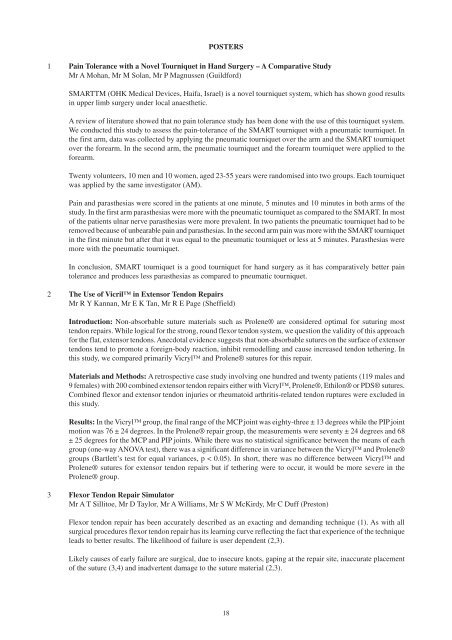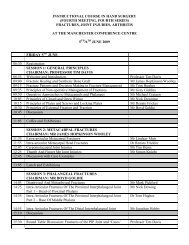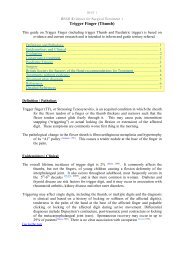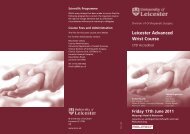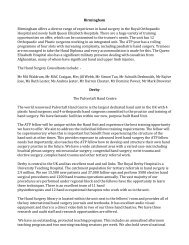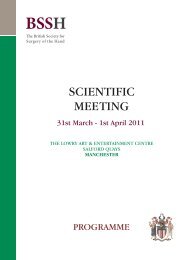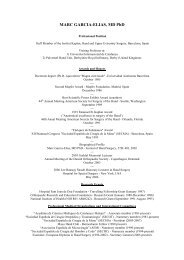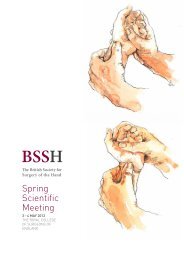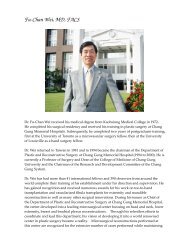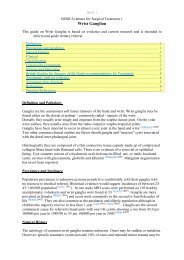here - The British Society for Surgery of the Hand
here - The British Society for Surgery of the Hand
here - The British Society for Surgery of the Hand
You also want an ePaper? Increase the reach of your titles
YUMPU automatically turns print PDFs into web optimized ePapers that Google loves.
POSTERS<br />
1 Pain Tolerance with a Novel Tourniquet in <strong>Hand</strong> <strong>Surgery</strong> – A Comparative Study<br />
Mr A Mohan, Mr M Solan, Mr P Magnussen (Guild<strong>for</strong>d)<br />
SMARTTM (OHK Medical Devices, Haifa, Israel) is a novel tourniquet system, which has shown good results<br />
in upper limb surgery under local anaes<strong>the</strong>tic.<br />
A review <strong>of</strong> literature showed that no pain tolerance study has been done with <strong>the</strong> use <strong>of</strong> this tourniquet system.<br />
We conducted this study to assess <strong>the</strong> pain-tolerance <strong>of</strong> <strong>the</strong> SMART tourniquet with a pneumatic tourniquet. In<br />
<strong>the</strong> first arm, data was collected by applying <strong>the</strong> pneumatic tourniquet over <strong>the</strong> arm and <strong>the</strong> SMART tourniquet<br />
over <strong>the</strong> <strong>for</strong>earm. In <strong>the</strong> second arm, <strong>the</strong> pneumatic tourniquet and <strong>the</strong> <strong>for</strong>earm tourniquet were applied to <strong>the</strong><br />
<strong>for</strong>earm.<br />
Twenty volunteers, 10 men and 10 women, aged 23-55 years were randomised into two groups. Each tourniquet<br />
was applied by <strong>the</strong> same investigator (AM).<br />
Pain and paras<strong>the</strong>sias were scored in <strong>the</strong> patients at one minute, 5 minutes and 10 minutes in both arms <strong>of</strong> <strong>the</strong><br />
study. In <strong>the</strong> first arm paras<strong>the</strong>sias were more with <strong>the</strong> pneumatic tourniquet as compared to <strong>the</strong> SMART. In most<br />
<strong>of</strong> <strong>the</strong> patients ulnar nerve paras<strong>the</strong>sias were more prevalent. In two patients <strong>the</strong> pneumatic tourniquet had to be<br />
removed because <strong>of</strong> unbearable pain and paras<strong>the</strong>sias. In <strong>the</strong> second arm pain was more with <strong>the</strong> SMART tourniquet<br />
in <strong>the</strong> first minute but after that it was equal to <strong>the</strong> pneumatic tourniquet or less at 5 minutes. Paras<strong>the</strong>sias were<br />
more with <strong>the</strong> pneumatic tourniquet.<br />
In conclusion, SMART tourniquet is a good tourniquet <strong>for</strong> hand surgery as it has comparatively better pain<br />
tolerance and produces less paras<strong>the</strong>sias as compared to pneumatic tourniquet.<br />
2 <strong>The</strong> Use <strong>of</strong> Vicril in Extensor Tendon Repairs<br />
Mr R Y Kannan, Mr E K Tan, Mr R E Page (Sheffield)<br />
Introduction: Non-absorbable suture materials such as Prolene® are considered optimal <strong>for</strong> suturing most<br />
tendon repairs. While logical <strong>for</strong> <strong>the</strong> strong, round flexor tendon system, we question <strong>the</strong> validity <strong>of</strong> this approach<br />
<strong>for</strong> <strong>the</strong> flat, extensor tendons. Anecdotal evidence suggests that non-absorbable sutures on <strong>the</strong> surface <strong>of</strong> extensor<br />
tendons tend to promote a <strong>for</strong>eign-body reaction, inhibit remodelling and cause increased tendon te<strong>the</strong>ring. In<br />
this study, we compared primarily Vicryl and Prolene® sutures <strong>for</strong> this repair.<br />
Materials and Methods: A retrospective case study involving one hundred and twenty patients (119 males and<br />
9 females) with 200 combined extensor tendon repairs ei<strong>the</strong>r with Vicryl, Prolene®, Ethilon® or PDS® sutures.<br />
Combined flexor and extensor tendon injuries or rheumatoid arthritis-related tendon ruptures were excluded in<br />
this study.<br />
Results: In <strong>the</strong> Vicryl group, <strong>the</strong> final range <strong>of</strong> <strong>the</strong> MCP joint was eighty-three ± 13 degrees while <strong>the</strong> PIP joint<br />
motion was 76 ± 24 degrees. In <strong>the</strong> Prolene® repair group, <strong>the</strong> measurements were seventy ± 24 degrees and 68<br />
± 25 degrees <strong>for</strong> <strong>the</strong> MCP and PIP joints. While t<strong>here</strong> was no statistical significance between <strong>the</strong> means <strong>of</strong> each<br />
group (one-way ANOVA test), t<strong>here</strong> was a significant difference in variance between <strong>the</strong> Vicryl and Prolene®<br />
groups (Bartlett’s test <strong>for</strong> equal variances, p < 0.05). In short, t<strong>here</strong> was no difference between Vicryl and<br />
Prolene® sutures <strong>for</strong> extensor tendon repairs but if te<strong>the</strong>ring were to occur, it would be more severe in <strong>the</strong><br />
Prolene® group.<br />
3 Flexor Tendon Repair Simulator<br />
Mr A T Sillitoe, Mr D Taylor, Mr A Williams, Mr S W McKirdy, Mr C Duff (Preston)<br />
Flexor tendon repair has been accurately described as an exacting and demanding technique (1). As with all<br />
surgical procedures flexor tendon repair has its learning curve reflecting <strong>the</strong> fact that experience <strong>of</strong> <strong>the</strong> technique<br />
leads to better results. <strong>The</strong> likelihood <strong>of</strong> failure is user dependent (2,3).<br />
Likely causes <strong>of</strong> early failure are surgical, due to insecure knots, gaping at <strong>the</strong> repair site, inaccurate placement<br />
<strong>of</strong> <strong>the</strong> suture (3,4) and inadvertent damage to <strong>the</strong> suture material (2,3).<br />
18


